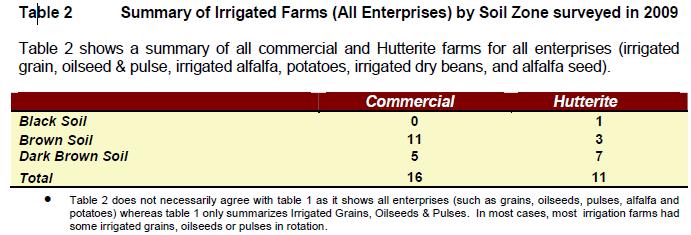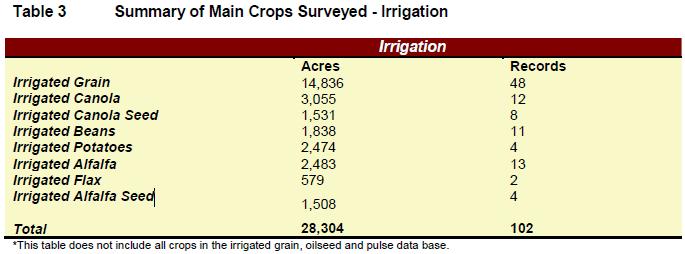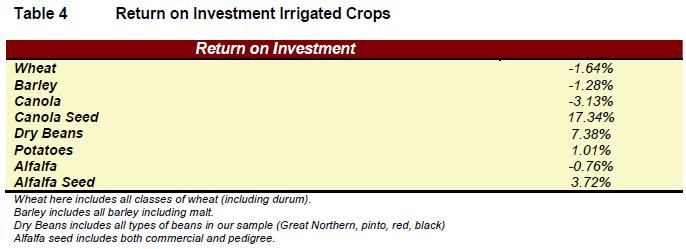| |
 Economics and Competitiveness Economics and Competitiveness
Executive summary | Introduction | Disclaimer | Download the complete study - 4.5 MB PDF
Executive Summary
MNP has been commissioned by Alberta Agriculture and Rural Development (ARD) to survey 2009 cost of production on large-scale (over 2,000 acres) grain farms in Alberta. In addition to surveying large scale grain farms the survey has looked closely at certain specialty irrigated crops. The dryland crops are the subject of a separate report. Included in the irrigated sample are approximately 11 Hutterite Colonies and 16 other farms in the South of the Province. This report will focus on the Irrigated, many of the farms surveyed had both dryland and irrigation and so are represented, with their respective data, in both reports.
In order to maintain confidentiality no farms have been identified; but where sample size permits the data has been analyzed according to Soil Zone.
These have been surveyed using farm questionnaires being utilized to supplement 2009 Agristability and Financial statement data. Almost the entire sample was from Assurance clients of the Consultants. This allowed the maximum use of accounting and farm program data prepared in a consistent fashion and subject to rigorous and consistent quality and reasonability review process. From the accounting and production data standpoint there is good comparability. However, by its very nature the farm-survey data is dependent upon the opinions/memories of the individual participants and is therefore less comparable.
The 2009 production year was characterized by commodity prices that were more reflective of the long-term past as commodity markets cooled-off along with the other recession hit markets globally. Production across most of Alberta was about as “normal” as could be expected except for the Peace Region which began to feel the effects of the drought that widened and deepened in 2010. The key driver(s) of the cost of production were, as was to be expected yield and total costs with the strongest correlation being to yield. Within the costs the key drivers were related to total investment and in particular machinery investment which varied widely (for example on irrigated farms the range was from under $1,000 per acre to over $6,000 although there was significant variation in the crops being grown.
By surveying the irrigated specialty crops as well as the grain crops grown in between those crops it has been possible to obtain a snapshot of the returns that are possible under irrigation that would not have been possible from looking at the grain crops alone. Indeed it is evident that the returns from irrigated grain crops do not justify investment in irrigation although a look at the specialty crops alone would tend to overstate the benefit of investing in irrigation systems.

“Mixed” farms (of which there were 5 amongst the Commercial group in table 1) are those with significant other, non-crop enterprises that are not included in the study but which may lend some benefit to the surveyed enterprises by way of additional “scale” for the whole operation. Hutterite colonies by their very nature are large scale mixed operations of a type not generally seen outside of the colonies.

All of the irrigated farms are in the South of the Province and their distribution within the various soil zones should not be altogether surprising.

Across the Irrigated Farms surveyed there were over 100 separate records and 30,000 acres
under irrigation about a third of which were the targeted specialty crops.

The Irrigated Sample mostly saw low to negative returns from their non specialty crops with Canola seed, Dry Beans and Alfalfa Seed showing the best returns.
Download the complete study - 4.5 MB PDF
Introduction
Grain, oilseed and pulse producers in Alberta in the 2007 and 2008 crop years experienced a period of unprecedented commodity price increases and dramatically improved profit margins. However, in 2009 after two years of extremely volatile markets for grains, oilseeds, and input prices the commodity sector began to re-approach its long term pricing levels and profitability. Historically these trends have been the driving force in the consolidation of grain farms and have constantly forced top producers to review the financial performance of their business.
Irrigation: This study was undertaken to better understand the financial performance of irrigation farms and the larger irrigated specialty crops that are exclusive to the Southern Alberta region. Farms in the irrigated report varied dramatically in size (from 500 acres to 7,500 acres of irrigated land). Specific individual farm financial information along with crop related data was collected from each of the participants to compile the report.
In the irrigation specialty report targeted crops were alfalfa hay, canola seed, potatoes, dry beans flax and alfalfa seed. Farm observation targets were for 25 to 28 irrigated specialty crop records. A summary of the farms surveyed is shown in table 5.

The Specialty Crops accounted for about 1/3 of the total irrigated acres surveyed. In addition to those in the table there were a further 2,815 acres of minor crops such as Meadow Brome, Fescue and Sweetcorn under irrigation. Their sample size was too small however to be meaningful.
The key deliverables of these reports include:
- Investment levels in the operations.
- Total investment (fair market value basis), by farm, in land, equipment and buildings.
- A comparison of investment levels according to farm size.
- Imputed investment levels, being defined as fair market value of total capital assets in use (land, machinery and buildings) whether owned by the producer or not (for example leased or rented).
- Production and cost of production information on an accrual basis.
- Productivity as defined by crop yields.
- Yield and examination of whether differences are apparent between different investment levels, scale of production and/or management factors.
- Other farm management factors were also surveyed.
- Equipment turnover (frequency of change of the major equipment items (frontline tractors, combines and sprayers).
- Labour usage.
- Cost of production benchmarking.
- A detailed breakdown of all variable and fixed costs for grain farms, on per acre and per unit of production basis.
- Physical input use for seed and fertilizer is also reported.
- Direct costs, fixed costs and total costs are compared for different scale farms.
- The information is further broken down in some reports by region, dryland, irrigated, irrigated specialty crop, soil zone, mixed farm and as well as a sub-set of Hutterite colonies.
This data is useful to the industry as a whole in understanding its overall competitiveness, the key drivers to profit in grain farms and the management practices of the top performers.
Individual participants will gain a detailed insight into their operation, where it stands within the data set and this will give clues as to how they might improve. With the use of a consistent and assured set of data and a consistent methodology the individual producers can be confident that they are being fairly compared to others and with this knowledge comes confidence in the analysis and from confidence in the analysis comes the motivation to make changes and improvements where they can be identified. The individual producers will receive a detailed benchmark report about their own crop operation and will be invited to participate in an extension session to summarize the reports results and conclusions.
Download the complete study - 4.5 MB PDF
Disclaimer
The information below contains data collected from Alberta agricultural producers to analyze cost of production, investment levels and productivity for the 2009 crop year. All information contained in this document has been modified to ensure producer anonymity. We informed participating producers that we were collecting the information for the purposes of carrying out a study for Alberta Agriculture and Rural Development, that participation was voluntary, that the information would be modified to ensure producer anonymity, and that the information would be shared with Alberta Agriculture and Rural Development unless the participating producer objected to such sharing.
The information in this report is intended for information purposes only and is not to be used or relied upon by any third party for any purpose. Circumstances are subject to future change and the analysis contained in this report involves uncertainties and is based on information that is also subject to change (e.g. prices, expenses, and production etc).
If you have any questions about this report or would like to discuss the information contained in it please use the contact details provided. |
|